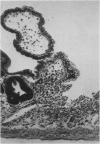Abstract
Thoracic irradiation induced duodenal lesions in mice as an indirect effect. We studied the influence of partial thoracic irradiation on endogenous histamine stores in the alimentary canal. Mice subjected to lower mediastinal irradiation had significantly higher (+19%) median gastric histamine, but lower (-44%) distal duodenal histamine than controls. They also had significantly lower proximal (-39%) and distal (-44%) duodenal histamine than mice who received upper mediastinal irradiation. Twenty-three percent of mice after lower mediastinal irradiation had duodenal lesions; these had significantly lower proximal (-30%) and distal (-44%) duodenal histamine than controls. Thus, irradiation to the lower mediastinum induced both duodenal lesions and significant changes in gastric and duodenal histamine stores. Histamine may be involved in the pathogenesis of these lesions.
Full text
PDF








Images in this article
Selected References
These references are in PubMed. This may not be the complete list of references from this article.
- Aures D., Davidson W. D., Håkanson R. Histidine decarboxylase in gastric mucosa of various mammals. Eur J Pharmacol. 1969 Oct;8(1):100–107. doi: 10.1016/0014-2999(69)90134-4. [DOI] [PubMed] [Google Scholar]
- Boesby S., Man W. K., Mendez-Diaz R., Spencer J. Effect of cysteamine on gastroduodenal mucosal histamine in rat. Gut. 1983 Oct;24(10):935–939. doi: 10.1136/gut.24.10.935. [DOI] [PMC free article] [PubMed] [Google Scholar]
- KAHLSON G., ROSENGREN E., SVAHN D., THUNBERG R. MOBILIZATION AND FORMATION OF HISTAMINE IN THE GASTRIC MUCOSA AS RELATED TO ACID SECRETION. J Physiol. 1964 Nov;174:400–416. doi: 10.1113/jphysiol.1964.sp007494. [DOI] [PMC free article] [PubMed] [Google Scholar]
- Man W. K., Boesby S., Spencer J. Gastric mucosal histamine, histamine formation capacity (HFC) and plasma gastrin after cysteamine administration. Br J Exp Pathol. 1984 Dec;65(6):759–765. [PMC free article] [PubMed] [Google Scholar]
- Michalowski A., Uehara S., Yin W. B., Burgin J., Silvester J. A. Alternative types of duodenal ulcer induced in mice by partial X irradiation of the thorax. Radiat Res. 1983 Jul;95(1):78–86. [PubMed] [Google Scholar]
- Ritchie W. P., Jr, Breen J. J., Grigg D. I. Prevention of stress ulcer by reducing gastric tissue histamine. Surgery. 1967 Oct;62(4):596–600. [PubMed] [Google Scholar]
- Szabo S., Haith L. R., Jr, Reynolds E. S. Pathogenesis of duodenal ulceration produced by cysteamine or propionitrile: influence of vagotomy, sympathectomy, histamine depletion, H-2 receptor antagonists and hormones. Dig Dis Sci. 1979 Jun;24(6):471–477. doi: 10.1007/BF01299831. [DOI] [PubMed] [Google Scholar]





